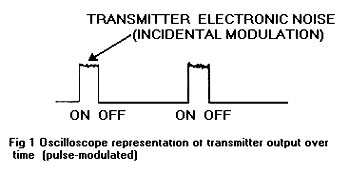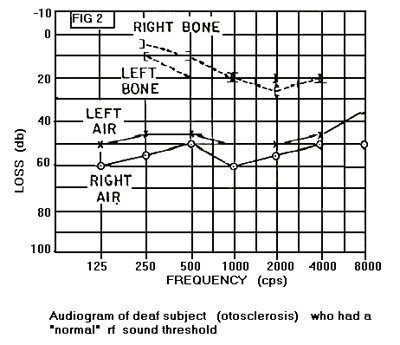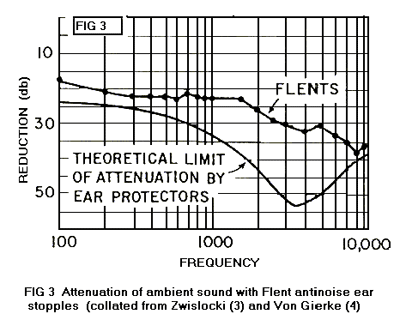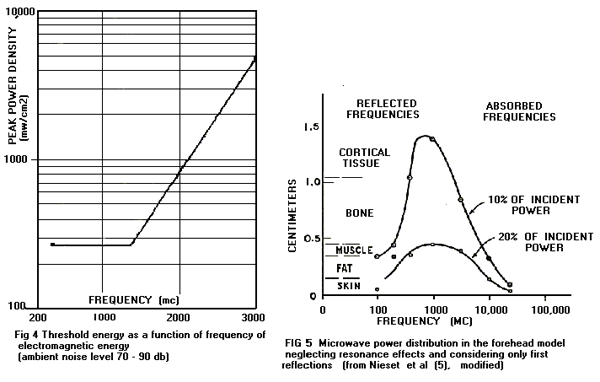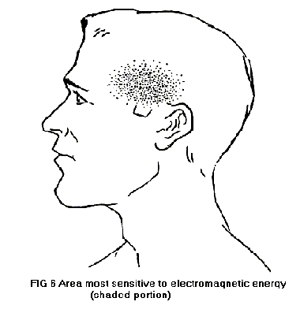|
by Allan H. Frey General Electric Advanced Electronics Center Cornell University, Ithaca, New York
Frey, Allan H. Human auditory systems response to modulated electromagnetic energy. J. Appl. Physiol. 17(4):689-692 1962
The intent of this paper is to bring a new phenomenon to the attention of physiologists. Using extremely low average power densities of electromagnetic energy, the perception of sounds was induced in normal and deaf humans. The effect was induced several hundred feet from the antenna the instant the transmitter was turned on, and is a function of carrier frequency and modulation.
Attempts were made to match the sounds induced by electromagnetic energy and acoustic energy. The closest match occurred when the acoustic amplifier was driven by the RF (radio frequency) transmitter's modulator. Peak power density is a critical factor and, with acoustic noise of approximately 80 db, a peak power density of approximately 275 mw/cm2 is needed to induce the perception at carrier frequencies of 425 mc and 1,310 mc.
The average power density can be at least as low as 400 uw/cm2. The evidence for the various possible sites of electromagnetic energy sensor are discussed and locations peripheral to the cochlea are ruled out.
A significant amount of research has been concerned with the effects of radio-frequency (RF) energy on organisms (electromagnetic energy between 1Kc and 100 Gc). Typically, this work has been concerned with determining damage resulting from body temperature increase. The average power densities used have been on the order of 0.1-1 w/cm2 used over many minutes to several hours.
In contrast, using average power densities measured in microwatts per square centimeter, we have found that other effects, which are transient, can be induced with this energy. Further, these effects occur the instant the transmitter is turned on. With appropriate modulation, the perception of various sounds can be induced in clinically deaf, as well as normal, human subjects at a distance of inches up to thousands of feet from the transmitter. With somewhat different transmitter parameters, we can induce the perception of severe buffeting of the head, without such apparent vestibular symptoms as dizziness or nausea. Changing transmitter parameters again, one can induce a "pins-and -needles" sensation.
Experimental work with these phenomena may yield information on auditory system functioning and, more generally, information on nervous system function. For example, this energy could possibly be used as a tool to explore nervous system coding, possibly using Neider and Neff's procedures (1), and for stimulating the nervous system without the damage caused by electrodes.
Since most of our data have been obtained on the "RF sound" and only the visual system has previously been shown to respond to electromagnetic energy, this paper will be concerned only with the auditory effects data. As a further restriction, only data from human subjects will be reported, since only these data can be discussed meaningfully at the present time.
The long series of studies we performed to ascertain that we were dealing with a biologically significant phenomenon (rather than broadcasts from sources such as loose fillings in teeth) are summarized in another paper (2), which also reports on the measuring instruments used in this work. The intent of this paper is to bring this new phenomenon to the attention of physiologists. The data reported are intended to suggest numerous lines of experimentation and indicate necessary experimental controls.
Since we were dealing with a significant phenomenon, we decided to explore the effects of a wide range of transmitter parameters to build up a body of knowledge which would allow us to generate hypotheses and determine what experimental controls would be necessary. Thus, the numbers given are conservative; they should not be considered precise, since the transmitters were never located in ideal laboratory environments. Within the limits of our measurements, the orientation of the subject in the RF field was of little consequence.
Most of the transmitters used to date in the experimentation have been pulse modulated with no information placed on the signal. The RF sound has been described as being a buzz, clicking, hiss, or knocking, depending on several transmitter parameters, i.e., pulse width and pulse-repetition rate (PRF). The apparent source of these sounds is localized by the subjects as being within, or immediately behind, the head. The sound always seem to come from within or immediately behind the head, no matter how the subject twists or rotates in the RF field.
Our early experimentation, performed using transmitters with very short square pulses and high pulse repetition rates, seemed to indicate that we were dealing with harmonics of the PRF. However, our later work has indicated that this is not the case; rather, the RF sound appears to be the incidental modulation envelope on each pulse, as shown in Fig. 1
As shown in Table 1, we have used a fairly wide range of transmitter parameters. We are currently experimenting with transmitters that radiate energy at frequencies below 425 mc, and are using different types of modulation, e.g., pulse-repetition rates as low as 3 and 4/sec. In the experimentation reported in this section, the ordinary noise level was 70-90 db (measured with a General Radio Co. Model 1551-B sound-level meter).
In order to minimize the RF energy used in the experimentation, subjects wore Flent antinoise ear stoppers whenever measurements were made. The Ordinary noise attenuation of the Flents is indicated in Fig. 3.
Although the RF sounds can be heard without the use of Flents, even above an ambient noise level of 90 db, it appears that the ambient noise to some extent "masked" the RF sound.
Table 2 gives the threshold for perception of the RF sounds. It shows fairly clearly that the critical factor in perception of RF sound is the peak power density, rather than the average power density. The relatively high value for transmitter B was expected and will be discussed below.
Transmitter G has been omitted from this table since the 20 mw/cm2 reading for it can be considered only approximate. The field-strength-measuring instruments used in that experiment did not read high enough to give an accurate reading. The energy from transmitter H was not perceived, even when the peak power density was as high as 25 w/cm2.
When the threshold energy is plotted as a function of the RF energy (Fig 4), a curve is obtained which is suggestive of the curve of penetration of RF energy into the head.
Figure 5 shows the calculated penetration, by frequency of RF energy, into the head. Our data indicate that the calculated penetration curve may well be accurate at the higher frequencies but the penetration at the lower frequencies may be grater than that calculated on this model.
As previously noted, the thresholds were obtained in a high ambient noise environment. This is an unusual situation as compared to obtaining thresholds of regular audio sound. Our recent experimentation leads us to believe that, if the ambient noise level were not so high, these threshold field strengths would be much lower.
Since one purpose of this paper is to suggest experiments, it might be appropriate to theorize as to what the RF sound threshold might be if we assume that the subject is in an anechoic chamber. It is also assumed that there is no transducer noise.
RF DETECTOR IN AUDITORY SYSTEM
One possibility that seems to have been ruled out in our experimentation is that of a capacitor type effect with the tympanic membrane and oval window acting as plates of a capacitor. It would seem possible that these membranes, acting as plates of a capacitor, could be set in motion by RF energy.
There are, however, three points of evidence against this possibility.
Another possible location for the detecting mechanism is in the cochlea. We have explored this possibility with nerve-deaf people, but the results are inconclusive due to factors such as tinnitus. We are currently exploring this possibility with animal preparations. The third likely place for the detection mechanism is the brain.
Burr and Mauro (6) presented evidence that indicates that there is an electrostatic field about neurons.
Morrow and Sepiel (7) presented evidence that indicates the existence of a magnetic field about neurons.
Becker (personal communication) has done some work indicating that there is longitudinal flow of charge carriers in neurons. Thus, it is reasonable to suspect that possibly the electromagnetic field could interact with neuron fields. As yet, evidence of this possibility is inconclusive.
The strongest point against is that we have not found visual effects although we have searched for them. On the other hand, we have obtained other nonauditory effects and found that the sensitive area for detecting RF sounds is a region over the temporal lobe of the brain.
One can shield, with a 2-in.sq. piece of fly screen, a portion of the strippled area shown in Fig. 6 and completely cut off the RF sound.
Another possibility should also be considered. There is no good reason to assume that there is only one detector site. On the contrary, the work of Jones et al (8), in which they placed electrodes in the ear and electrically stimulated the subject, is sufficiently relevant to suggest the possibility of more than one detector site.
Also, several sensations have been elicited with properly modulated electromagnetic energy. It is doubtful that all of these can be attributed to one detector. As mentioned earlier, the purpose of this paper is to focus the attention of physiologists on an unusual area and stimulate additional work on which interpretations can be based.
Interpretations have been deliberately omitted from this paper since additional data are needed before a clear picture can emerge. It is hoped that the additional exploration will also result in an increase in our knowledge of nervous system functions.
REFERENCES:
|

